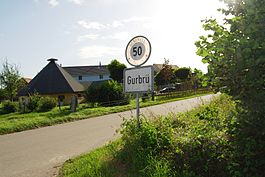Gurbrü
| Gurbrü | ||
|---|---|---|
 |
||
|
||
| Coordinates: 46°57′N 7°12′E / 46.950°N 7.200°ECoordinates: 46°57′N 7°12′E / 46.950°N 7.200°E | ||
| Country | Switzerland | |
| Canton | Bern | |
| District | Bern-Mittelland | |
| Government | ||
| • Mayor | Fredi Hurni-Herren | |
| Area | ||
| • Total | 1.84 km2 (0.71 sq mi) | |
| Elevation | 484 m (1,588 ft) | |
| Population (Dec 2015) | ||
| • Total | 246 | |
| • Density | 130/km2 (350/sq mi) | |
| Postal code | 3208 | |
| SFOS number | 0665 | |
| Surrounded by | Wileroltigen, Ferenbalm, Agriswil, Ried bei Kerzers, Kerzers | |
| Website |
http://www.gurbrue.ch SFSO statistics |
|
Gurbrü (French: Corbruil) is a municipality in the Bern-Mittelland administrative district in the canton of Bern in Switzerland.
Gurbrü is first mentioned in 1214 as Gurbru.
During the Middle Ages Gurbrü village was part of the Herrschaft of Oltigen. In 1410/12, the city of Bern absorbed the entire Herrschaft, including Gurbrü. The village was always part of the parish of Kerzers. During the Protestant Reformation, in 1528, both municipalities converted to the new faith and Gurbrü remained part of the Kerzers parish. In 1793, it fought with the neighboring communities, in the Canton of Fribourg, over the Gurbrümoos moor. The Gurbrümoos is now part of the Bernese municipality of Kallnach. After the 1798 French invasion, Golaten remained part of the Canton of Bern, despite attempts by the Canton of Fribourg to annex it. In 1901 the Bern-Neuchatel railroad built a station in the municipality.
Gurbrü has an area of 1.84 km2 (0.71 sq mi). As of 2012, a total of 1.3 km2 (0.50 sq mi) or 70.7% is used for agricultural purposes, while 0.18 km2 (0.069 sq mi) or 9.8% is forested. Of the rest of the land, 0.35 km2 (0.14 sq mi) or 19.0% is settled (buildings or roads).
During the same year, housing and buildings made up 7.1% and transportation infrastructure made up 11.4%. Out of the forested land, 8.2% of the total land area is heavily forested and 1.6% is covered with orchards or small clusters of trees. Of the agricultural land, 54.3% is used for growing crops and 13.6% is pastures, while 2.7% is used for orchards or vine crops.
...
Wikipedia




